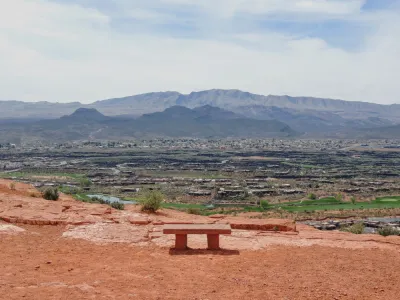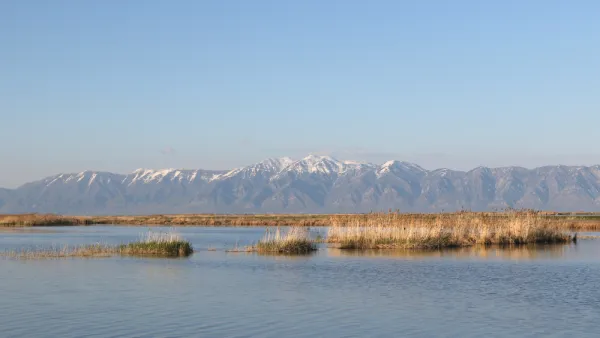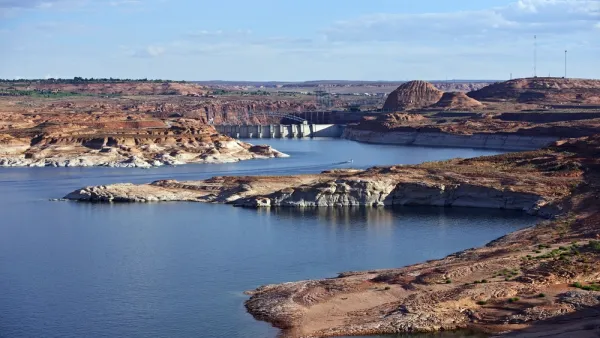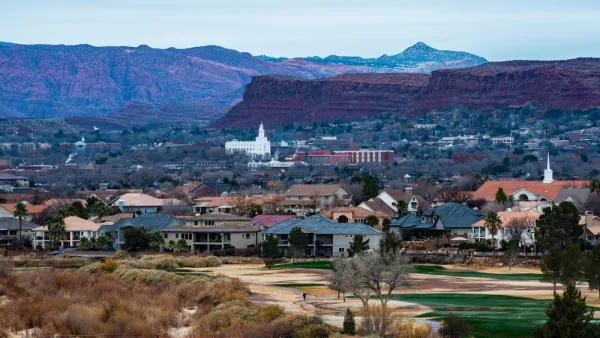Cheap water flows freely to the golf courses of St. George, Utah, but all the new residents mean it’s going to have to increase supply or reduce demand—or both.

St. George, Utah was recently named the fastest growing metropolitan area in the country; it is also in one of the driest climates in the country, which means that providing enough water will be an enormous challenge, writes Jake Bullinger at CityLab.
As is the case with other growing desert burgs, St. George grapples with water-supply issues. But the challenge here is unique. Remarkably cheap rates mean that residents of an area with only eight inches of annual rainfall are using tremendous amounts of water. An average St. George resident uses more than twice as much water as the average citizen of Los Angeles.
As in many dry cities, one of the most significant uses of water is outdoor irrigation (St. George has traditionally been a retirement community, with lots of golf courses). In some places, watering all that grass would be an expensive proposition, but in most of Utah, untreated "secondary water" is nearly free.
The question for St. George now is whether to push forward with a major infrastructure project that would provide a new source of water, or to focus on reducing demand through conservation.
The project—a pipeline that would bring more water from Lake Powell—is hugely expensive, but even if it weren’t, there’s a question of how much more water can be wrung from the Colorado River, which is shrinking in the short term due to drought and in the long term due to climate change.
“In this blossoming desert city,: Bullinger writes, “leaders have a choice: Do they let the roses go brown, or pay exorbitantly to keep them?”
FULL STORY: America's Fastest-Growing Urban Area Has a Water Problem

National Parks Layoffs Will Cause Communities to Lose Billions
Thousands of essential park workers were laid off this week, just before the busy spring break season.

Retro-silient?: America’s First “Eco-burb,” The Woodlands Turns 50
A master-planned community north of Houston offers lessons on green infrastructure and resilient design, but falls short of its founder’s lofty affordability and walkability goals.

Delivering for America Plan Will Downgrade Mail Service in at Least 49.5 Percent of Zip Codes
Republican and Democrat lawmakers criticize the plan for its disproportionate negative impact on rural communities.

Test News Post 1
This is a summary

Test News Headline 46
Test for the image on the front page.

Balancing Bombs and Butterflies: How the National Guard Protects a Rare Species
The National Guard at Fort Indiantown Gap uses GIS technology and land management strategies to balance military training with conservation efforts, ensuring the survival of the rare eastern regal fritillary butterfly.
Urban Design for Planners 1: Software Tools
This six-course series explores essential urban design concepts using open source software and equips planners with the tools they need to participate fully in the urban design process.
Planning for Universal Design
Learn the tools for implementing Universal Design in planning regulations.
EMC Planning Group, Inc.
Planetizen
Planetizen
Mpact (formerly Rail~Volution)
Great Falls Development Authority, Inc.
HUDs Office of Policy Development and Research
NYU Wagner Graduate School of Public Service





























